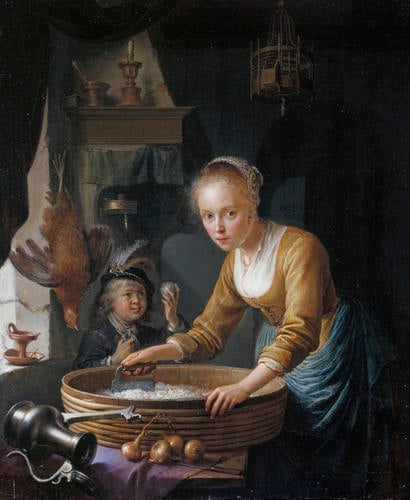-
1 of 253523 objects
A Girl chopping Onions Signed and dated 1646
Oil on panel | 20.8 x 16.9 cm (support, canvas/panel/stretcher external) | RCIN 406358
-
Dou was the founder of the school of the so-called fijnschilders (Fine-Painters) in Leiden. As the term denotes, the style used by Dou and his numerous followers involved meticulous brushwork, close observation of objects, and a high degree of finish to the extent that the surfaces of their pictures look almost as if they have been polished.
A girl chopping onions is on a minute scale and is a perfect demonstration of the art of fijnschilders painting. The activities of kitchenmaids was one of Dou’s favourite themes, in which he could not only indulge in brilliant passages of still-life painting, but also pursue artistic themes. Lascivious kitchenmaids were frequently the subject of comedic literature in seventeenth-century Holland, and painters emphasised their charms by the use of symbolism based on contemporary emblem books or proverbs. Thus, the empty bird-cage may be an allusion to loss of virtue and the dead fowl is a double entendre - the Dutch word vogel (bird) was also a slang term for ‘copulation’. Many of the utensils in the picture - such as the candle, pestle and mortar, and the jug - have clear sexual connotations. In addition, the kitchenmaid looks straight out at the viewer whilst suggestively engaged in chopping onions, which in the seventeenth century were used as an aphrodisiac. All these disparate aspects, however, might be united in a wider meaning personified by the two figures: the small boy standing for innocence and the girl for experience. Yet this was not how it was interpreted when the picture was in France during the eighteenth century. When engraved by Pierre Louis Surugue the following caption was supplied as imaginary dialogue between the small boy (perhaps seen as Cupid) and the young woman: ‘I am perfectly willing to believe that you are knowledgeable in the delectable art of preparing stews / But I feel even more appetite for you / Than for the stew that you are preparing.’
The motif of chopping onions first occurred in The Kitchen of c.1645 (Staatens Museum, Copenhagen) in which the same small boy also appears. The view into the kitchen is here made possible by the raised curtain which Dutch artists began to use during the 1640s as an illusionistic device.
Inscribed: GDOV 1646
Catalogue entry adapted from Enchanting the Eye: Dutch paintings of the Golden Age, London, 2004Provenance
In various eighteenth-century French collections - Gaignat, Choiseul, Prince de Conti, Choiseul-Praslin - before entering the collection of Jan Gildemeester in Amsterdam and the Baring collection in London. Purchased by George IV from Sir Thomas Baring as part of a group of 86 Dutch and Flemish paintings, most of which were collected by Sir Thomas’s father, Sir Francis Baring; they arrived at Carlton House on 6 May 1814; recorded in the anti-room to the Dining Room at Carlton House in 1819 (no 95); in the Picture Gallery at Buckingham Palace in 1841 (no 136)
-
Creator(s)
(nationality)Acquirer(s)
-
Medium and techniques
Oil on panel
Measurements
20.8 x 16.9 cm (support, canvas/panel/stretcher external)
18.0 x 14.8 cm (support (etc), excluding additions)
37.3 x 33.5 x 5.0 cm (frame, external)
Other number(s)
Alternative title(s)
Le Hâchis d'oignons, previously entitled
